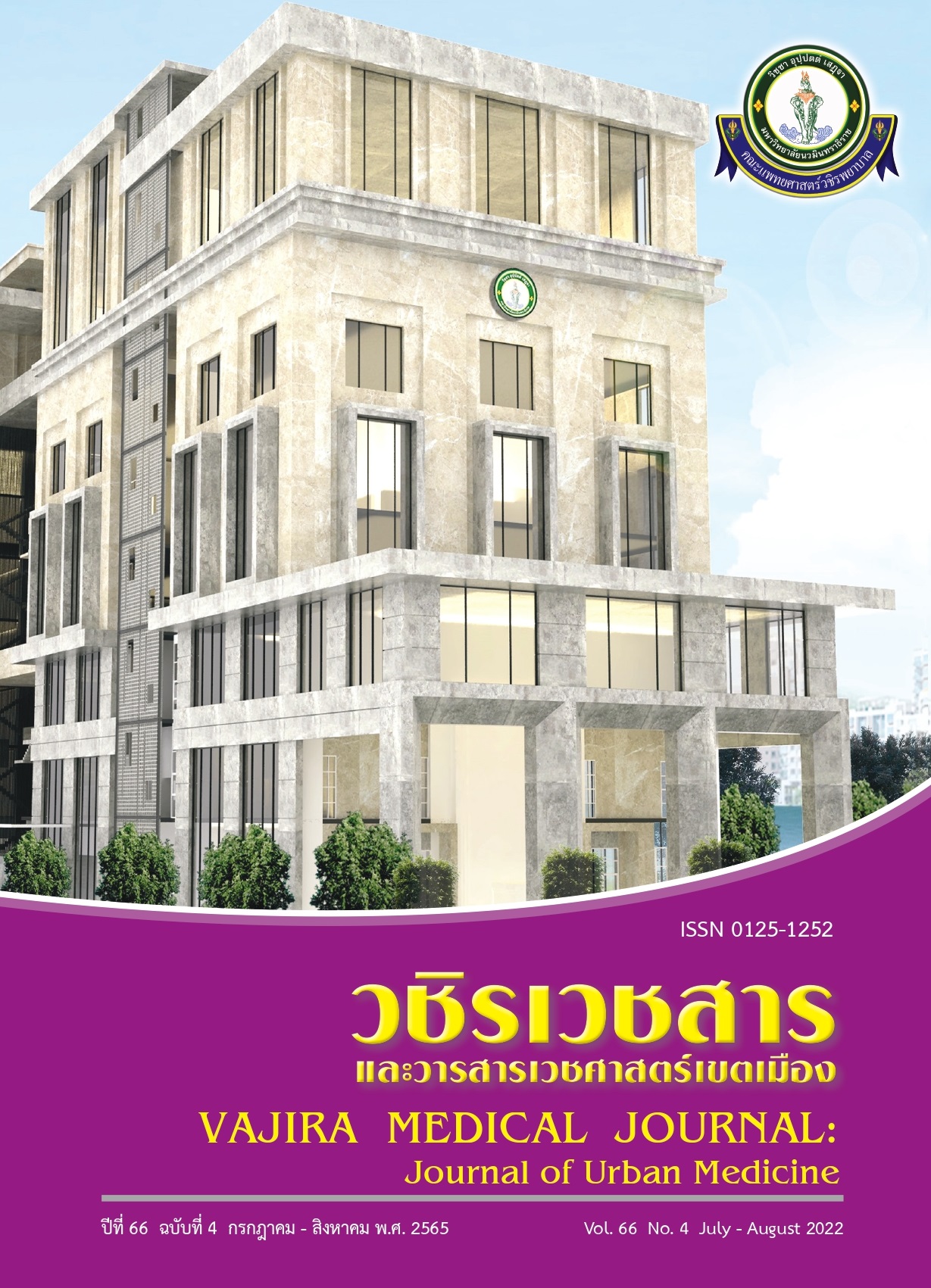Incidence and Risks of Readmission due to Neonatal Jaundice
Main Article Content
Abstract
Objective: To study the incidence and risk factors of the newborn infants 35 or more weeks of gestation who were readmitted due to neonatal jaundice within 7 days after discharged from Vajira Hospital, Navamindradhiraj University.
Methods: Data from the medical records of the newborn infants 35 or more weeks of gestation who were readmitted due to neonatal jaundice within 7 days after discharged from Vajira Hospital from January 1st, 2019 to December 31st, 2020 were collected and reviewed as a retrospective descriptive study.
Results: During 2019-2020, the incidence of readmission due to neonatal jaundice of the newborn infants 35 or more weeks of gestation within 7 days after discharged from Vajira hospital was 5.4% (208 infants) and 32.2% (68 infants) who were previously on phototherapy in the last admission. The common causes of readmission of the study group were unknown cause 51.4%, G6PD deficiency and breast-non-feeding jaundice were the same rate 15.9% and jaundice due to prematurity 10.1%.
Conclusion: The incidence of readmission due to neonatal jaundice at Vajira hospital was relatively low compared with other studies. The most common causes were an unknown cause, G6PD deficiency, inadequate breastfeeding and jaundice of prematurity.
Downloads
Article Details

This work is licensed under a Creative Commons Attribution-NonCommercial-NoDerivatives 4.0 International License.
References
Ngenchum S. Neonatal Jaundice [Internet]. 2018. [cited 2020 September 26]. Available from: https://www.si.mahidol.ac.th/sidoctor/e-pl/admin/article_files/1238_1.pdf
Thai Neonatal Society. Basic newborn care. Bangkok: Division of Neonatology, Department of Pediatrics, Faculty of Medicine Ramathibodi Hospital; 2013. p. 335–51.
American Academy of Pediatrics Subcommittee on Hyperbilirubinemia. Management of hyperbilirubinemia in the newborn infant 35 or more weeks of gestation. Pediatrics 2004; 114(1): 297-316.
Piazza A, Stroll B. Jaundice and hyperbilirubinemia in the newborn. In: Saunders W, editor. Nelson textbook of Pediatrics 18th ed. Philadelphia; 2007. p. 756–66.
Thaithumyanon P. Neonatal Jaundice in Newborn. Bangkok: Chaicharoen; 2002. p. 96–106.
Chotikiat U. Neonatal Hyperbilirubinemia. In: Singkalwanich S, Sangtaweesin C, Sriudomkachon S, Kanchanapongkul S, editors. Hot Issues in Pediatrics. Bangkok: Thana Press; 2006. p. 359–64.
Sukkayanudit N, Hospital T, Province S. Prevalence and Risk Factors of Re-admission for Phototherapy in Early Neonatal Jaundice in Thatoom Hospital, Surin Province. J Off DPC6 Khon Kaen 2013;20(1):19–30.
Zohreh K, Nahid M, Ali A, Susan A, Zahra K, Mohammad T. Prevalence of Readmission for Hyperbilirubinemia in Healthy Newborns. Iran J Pediatr Jun 2008;18 (2):130-6.
Sae-Tia P. Neonatal hyperbilirubinemia in Nangrong Hospital Buriram Province. Med J Srisaket Surin Buriram Hosp 2007;22(3):461–7.
Wanichchinchai N. Factors Influencing Levels of total Serum Bilirubin in Infants after Receiving Phototherapy. Reg 4 Med J 2000;19(1):33–41.


